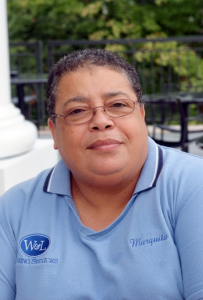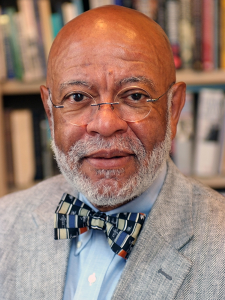By Gus Cross
The Rockbridge area has had NAACP chapters in the past, particularly active in the 1950s and late 20th century. But these chapters dissolved as leadership grew older or left the area.
The NAACP, the National Association for the Advancement of Colored People, is the oldest and one of the most widely known civil rights organizations in the United States. It was formed in 1909 in response to the frequent lynching of black people and anti-black riots in Springfield, Ill. Occasionally criticized for addressing issues of discrimination solely through judicial and legislative means, it had its greatest impact with the successful overturning of school segregation in 1954.
Now, in reaction the current presidential administration and neo-Confederate protests around the removal of Confederate monuments, Rockbridge residents have started to form a new Rockbridge County NAACP chapter. Some say this chapter is “long overdue.”

Marquita Dunn, who currently works for General Services for Café 77 at Washington and Lee University, was nominated for the vice president position of the new chapter. She said even before the chapter started to form people would come up and talk to her about discrimination and racism problems in the Rockbridge area. While she recognized a problem, there was not much she, or anyone else, could do.
“We just didn’t have anybody to advocate for these problems,” said Dunn.
The idea to form a new chapter began during an evening speaker event on Martin Luther King Jr. Day this past January at Randolph Street United Methodist Church. Pastor Michael Turner of Ebenezer Baptist Church in Staunton, one of the guest speakers, challenged local residents to start a new chapter. According to the Rev. Reginald A. Early, the pastor at RSUMC, from there, the effort to start the chapter was taken up by many active community leaders and by organizations such as the Community Anti-Racism Effort (CARE Rockbridge) and 50 Ways Rockbridge, the local chapter of a national group formed after the Women’s March on Jan. 21.
According to Early, 50 Ways, which has 16 “Issues Groups” including one that deals strictly with racial justice, “propelled” the movement to start the chapter. “The Racial Justice Issue [Group] just picked it up and ran with it,” said Early.

From there, organizing leaders began to contact the NAACP national headquarters to find out the steps required to form a new chapter. In March, Virginia’s NAACP Area 12 leadership held a training session in Lexington to teach those interested in organizing the new chapter about what the NAACP does, its objectives, its mission, the history of the NAACP, and the roles of the different officers required to form a chapter.
Prof. Theodore C. DeLaney, who teaches history at W&L, said the action to form a new chapter was also made in response to the “perception that there is some regression towards Jim Crow-style segregation.” Following the 2016 presidential election the Ku Klux Klan, American Nazi Party, and other alt-right groups felt emboldened to come out from the shadows and openly protest minorities in the United States. DeLaney added that for the most part, the forming of this chapter and similar actions taken across the United States are part of a resistance to this “regression … or fear of regression into the American past.”
DeLaney, while not currently a part of 50 Ways Rockbridge or the forming chapter, said the new chapter will most likely work to bring the community closer together. According to Dunn, one thing the chapter hopes to work on specifically is the way history is taught in the Rockbridge County school system.
“Right now in the public schools, the history that is being taught is sugar-coated,” Dunn said. She said only certain parts of U.S. history are taught and a lot of important history regarding the Civil War and the Civil Rights Era are skipped over.
Issues with the disparity of school punishments between white students and students of color is another area that organizers want addressed. When speaking on this issue, Early referenced an Oct. 17 article in the Richmond Times-Dispatch that said black students in Virginia were suspended about four times as much as Hispanic and white students in 2015-16.
“I have heard some stories about how African Americans students are treated – they are not treated the same as white students,” said Early. “We want to look at that and see where the disparities are with suspensions and expulsions.”
There is also concern with the lack of minority teachers and administrators in the school system, but discrimination in other areas of employment have been reported to local civil rights leaders as well.
“The mission of the NAACP is exactly to address those issues, but more specifically is to ensure the equality of all races and eliminate discrimination,” said Early.
There has been some discussion of potentially forming a high school NAACP chapter, in addition to chapters at W&L and at the Virginia Military Institute. W&L formerly had a NAACP group in the early 2000s. According to Courtney Penn, who worked as an associate dean of students at W&L at the time, the group’s formation then was a reaction to “things going on on campus that students felt like they needed to organize around, probably not unsimilar to what is happening now.”
The reaction Penn referred to was the controversy over a Mock Convention t-shirt made by the Idaho delegation in 2000. The t-shirt read on the back, “I da ho” and pictured an African American woman wearing tights, boots, and other provocative clothing in order to depict a prostitute. The controversy eventually led to the firing of the former Assistant Baseball Coach John Baizely for his part in designing the t-shirt. The controversy also led to the Idaho delegation recalling its t-shirts in an attempt to prevent people from wearing them around campus.
According to Penn, interest in the W&L NAACP group, which never became a recognized chapter, declined “the further we got out from the [t-shirt] incident.” He said the phasing out of the group was due more in part to other priorities rising than to a lack of interest.
The dissolution of the W&L NAACP group coincided with the decline of the Lexington NAACP chapter. The Lexington chapter formally disbanded not long after the leader of the Lexington chapter, former Pastor LaVert H. Taylor, left to work in Nevada. Taylor, who has since died, served as the pastor of the First Baptist Church in Lexington, but also served on the Lexington City Council and was the chaplain for the Lexington Police Department and Rockbridge Area Hospice. Dunn, who was a member of the former chapter, said once Taylor left the area in 2004, interest in the chapter waned and it ended up dissolving.
However, by the end of the calendar year, minority residents of the Rockbridge area will have a new chapter to advocate for them as the chapter draws closer to being recognized. In order for the group to be recognized there need to be at least 50 members who have paid the $30 fee as well as elected officers for the chapter. Nominations for officer positions took place Oct. 3 but anyone can be nominated until the election which will take place on Dec. 5.
Currently, each office position has only one nominee. Nominated for president is Maria Quillin, Dunn has been nominated for the first vice president position while Jeanne Wilson was nominated for the second vice president position, in case Dunn needs to step down. Mimi Sloan is the nominee for secretary, Ken Davis for treasurer, and Debbie Funkhouse for assistant treasurer.
